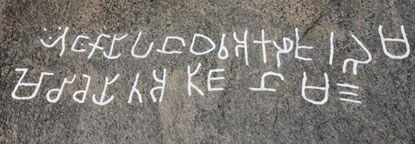Ancient numbers in the land of Ramanujan
by Iravatham Mahadevan and M. V. Bhaskar
How were numerals written in ancient times in the Tamil country, the
land of Srinivasa Ramanujan, 'The Man Who Knew Infinity'?Literary
sources in Tamil mention numbers only in words.
|

The Hindu Tamil-Brahmi cave inscription from Tondur (3rd century
C.E.).
Photo Courtesy: Central Institute of Classical Tamil, Chennai |
However, we do have ancient literary references specifically
mentioning eN ('numeral') as distinguished from ezhuttu ('letter of the
alphabet,' for example, Tolkappiyam 655.4, Tirukkural 392).
But as palm leaf manuscripts decay with time and hardly last for more
than 200 years, we have to turn to durable stone or pottery inscriptions
to know what the ancient Tamil numerals looked like. The oldest stone
inscription featuring a numeral is the Tamil-Brahmi cave inscription
from Tondur, near Gingee, in Villupuram district, assigned to about the
3rd century C.E.
The numeral 3 engraved at the end of a short two-line inscription in
the cave is represented by three horizontal parallel lines.
The inscription records that the village of Agalur gifted three stone
beds in the cave chiselled by Mosi.
The gift was made to the Jaina monks resident in the cave. The
village still exists with the same name Agalur, near Tondur, both of
which still have sizeable Jaina populations.
The numeral 3 has the same form as in contemporary Prakrit
inscriptions in the Brahmi script in North India.
Pottery inscription
A well-preserved pottery inscription from Alagankulam near Rameswaram
has only the numeral incised in fairly large size. The inscription is
dated to the 1st or 2nd century C.E.
The number is read 408, from right to left, following the ancient
convention of reading the digits from the right (ankaanaam vaamato
gatih).
The first digit at right looking like the cross is the symbol for 4.
It is followed by the symbol for 100 (resembling the Brahmi letter
sa) and the last symbol at left is 8, incised in reversed direction.
Interesting
As there is no accompanying text, we do not know the significance of
the number.
The find is still interesting for the absence of the place-value
system.
The convention of using symbols for 10, 100, and 1000 in expressing
the higher numerals was current in Tamil Nadu until the advent of
printing and the adoption of the international form of Indian numerals
with place-value system.
The pottery inscription is also good evidence for widespread
literacy, including numeracy, in the ancient Tamil country.
-The Hindu |

